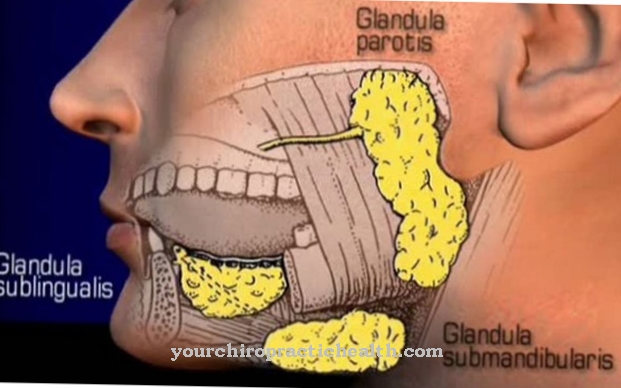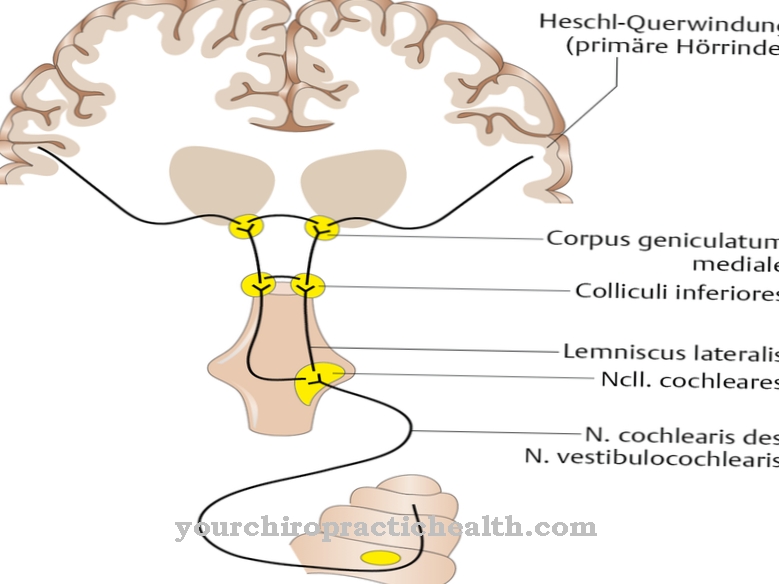The Swivel joint corresponds to one wheel- or Pivot joint. A pin rests in a groove in these joints and enables movements such as rotation there. The ulnar-spoke joint in particular is prone to injuries and illnesses.
What is the swivel joint?
Bones meet in the human body in articulated connections called joints, which are divided into fake and real joints. The real joints have a joint space and have different shapes.
A shape variant of the real joints is the so-called swivel joint. They are made up of a tenon and a gutter. The peg-shaped joint surface engages in the groove-shaped joint socket according to the hand-in-glove or the key-in-lock principle. Rotary joints play an essential role in the mobility of the arm bones. For example, the radioulnar joint is a swivel joint in the distal and proximal planes. All swivel joints are so-called flat joints, which do not have a geometric center of movement.
In addition to the typical swivel joints on the ulna and radius, the vertebral or intervertebral joints are also flat joints. Rotary joints are either pivot joints or wheel joints. For swivel joints, a translational degree of freedom applies in relation to the movement, i.e. their movements are straight. Compared to other joints, swivel joints are more rigid than dynamic joints.
Anatomy & structure
The anatomy of every real joint, i.e. every diarthrosis, is characterized by a gap between the two bones. This gap corresponds to the joint gap. Healthy joint surfaces are always covered by cartilage and lie in a joint capsule, which is composed of an outer fibrous membrane of the tight connective tissue and an inner synovial membrane of epithelial-like connective tissue associations.
Capsular or joint ligaments strengthen the outer joint membrane. A layer of the synovial membrane, which is connected to the joint capsule, lies on stabilizing ligaments in the joint cavity. The joint cavity is completely enclosed by the joint capsule, which rests loosely on the joint body and contains the viscous synovial fluid. This is a fluid also called synovia. As a real joint, the swivel joint is also characterized by the properties described. The further anatomy of the swivel joints depends on whether they are the sub-shape of the wheel or pivot joint.
With a wheel joint, the joint socket moves around a fixed pin. In the case of the pivot joint, the pivot is to be understood as a joint head and moves in the associated joint socket. Normally, the pivot of the swivel joint rests in the short, trough-like socket and is stabilized in this position by tight, circular ligaments.
Function & tasks
Joints have several tasks: they connect bones to one another, stabilize the bone connection and enable the bones involved to have a certain degree of movement at the same time. How great this degree of movement is and how many axes it comprises depends on the location and shape of the joint. Rotary joints are more static compared to other types of joint and usually have a single axis of movement that allows translational and thus straight movements.
Rotational movements such as internal rotation and the associated external rotation are implemented in swivel joints. In addition, swivel joints are usually capable of pronation and supination. The supination and the opposite pronation are particularly relevant with regard to the radioulnar joint. It is a wheel joint with a single axis of movement: rotation. The proximal radioulnar joint is also known as the ulnar-spoke joint close to the body and connects the inside of the ulna with the head of the spoke. This is where the rotating movements of the forearm take place.
The distal ulnar-spoke joint is close to the wrist and is responsible for the rotation of the hand. This applies in particular to the inward rotation of the forearm, in which the thumb side of the associated hand rotates medially and the back of the hand rotates forward. This pronotation of the forearm is made possible by muscles such as the pronator quadratus muscle, the pronator teres muscle, and the brachioradialis muscle at a nerve-mediated command from the central nervous system.
Supination is the opposite movement that returns the forearm to its original position. During internal rotation in the swivel joint, an extremity rotates around its own longitudinal axis and, viewed from the front, points inwards in its direction of rotation. External rotation is the opposite process. The more degrees of freedom a swivel joint has and the higher the degree of movement, the more likely are pathological incidents such as joint twisting.
Diseases
Pathological phenomena often take place in the proximal and distal ulnar-spoke joint in particular. These swivel joints of the body are highly complex constructions. The guidance of the distal ulnar-spoke joint depends on two side ligaments and a so-called ring ligament.
With the joint, these ligaments form a functional unit that is enclosed by the joint capsule. The advantage of the elbow construction is the tripartism. Three partial joints meet in the elbow and allow a high range of motion. In addition, the ligaments of the elbow are strong enough to give the structure the stability it needs. Due to the stable flexibility in the elbow, humans can make relatively nimble movements with the forearm and at the same time carry heavy objects without damaging the joint.
If the load is incorrect, the swivel joint between ulna and radius and hand and forearm are prone to injuries. After a monotonous load, the wheel joints are again accessible to overload diseases. Injuries usually affect the ligaments of the joints. Overstretching or torn ligaments are not uncommon in these structures. In addition, the joint can also suffer from inflammation due to incorrect or overloading. The swivel joint fills with synovia and causes severe pain. The swivel joints in the elbow are also susceptible to pathological phenomena as a result of an accident, as the elbow is relatively exposed.
The joints can fill with blood as a result of an accident, for example, and cause hemarthrosis, which in the course of the process damages the articular cartilage. In addition, there are age-related signs of wear and tear. If the age-related wear and tear on the joints exceeds a certain level, it is called osteoarthritis. In addition to overload, bone fracture-related malpositions and incorrect loads can be responsible for the painful disease.



























